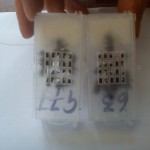 Exciting news arrived in the post today, the delivery of our new Queen Bee, she is a Native Irish Black Bee. Many thanks to Aoife Mac Giolla Coda from Galtee Bee Breeding Group. The Native Irish Honey Bee is often called the ‘Black Bee’ as it is generally dark in colour – although the colour can vary. It is a strain of the Dark European Honey Bee (Apis mellifera mellifera) which is indigenous to Ireland, Britain, Scandinavia, parts of northern and central mainland Europe. What makes it so special? It is naturally adapted to our cool,damp, oceanic climate. These bees are very good at sparing their honey stores in bad weather. More exotic strains of honey bee eat through their honey stores more quickly, which could lead to starvation. Native honey bees are better at flying out and collecting nectar and pollen in colder, damper days in the summer, whereas honey bees imported from warmer climates generally need a higher temperature before they can do so. Being naturally adapted to the Irish climate, they have developed resistance to many bee diseases. They are also much hairier, which helps them to cope with cold, wet summers, yet they also perform exceptionally when the temperature rises. They are also excellent honey producers and will give a crop of honey even in mediocre summers. While we had a bad summer last year, the reports have shown that the native honey bees have coped reasonably well with most beekeepers having a reasonable crop of honey from their native honey bees.
Exciting news arrived in the post today, the delivery of our new Queen Bee, she is a Native Irish Black Bee. Many thanks to Aoife Mac Giolla Coda from Galtee Bee Breeding Group. The Native Irish Honey Bee is often called the ‘Black Bee’ as it is generally dark in colour – although the colour can vary. It is a strain of the Dark European Honey Bee (Apis mellifera mellifera) which is indigenous to Ireland, Britain, Scandinavia, parts of northern and central mainland Europe. What makes it so special? It is naturally adapted to our cool,damp, oceanic climate. These bees are very good at sparing their honey stores in bad weather. More exotic strains of honey bee eat through their honey stores more quickly, which could lead to starvation. Native honey bees are better at flying out and collecting nectar and pollen in colder, damper days in the summer, whereas honey bees imported from warmer climates generally need a higher temperature before they can do so. Being naturally adapted to the Irish climate, they have developed resistance to many bee diseases. They are also much hairier, which helps them to cope with cold, wet summers, yet they also perform exceptionally when the temperature rises. They are also excellent honey producers and will give a crop of honey even in mediocre summers. While we had a bad summer last year, the reports have shown that the native honey bees have coped reasonably well with most beekeepers having a reasonable crop of honey from their native honey bees.
Never has it been more important or more difficult to support or keep the dark native Irish honey bee (Apis mellifera mellifera). Einstein estimated that the human race will only survive for approx four years, if the honey bee becomes extinct. Contrary to common belief, the main task of the honey bee is pollination, honey is a by product. Without pollination there will be no food… there are parts of the world, especially Japan where it is now necessary to hand pollinate crops.
The problem with many bees is that they are unable to store large amounts of honey, so when they can’t find enough to eat and the honey in the nest runs out, the larvae starve to death. The answer is to make sure that we use gardens and spare land to grow plants that bees like, and to make sure that there is a range of plants to create more diversity in the crops available.
The Fedration of Irish Beekeepers have an interesting website where they list the flowers and plants that are suitable for bees. Click here for their site
Video of the Queens arrival